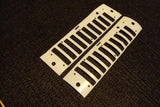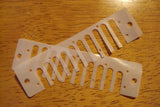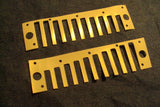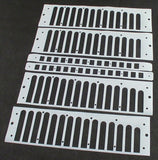*Inventory Reduction* Gaskets for Diatonic and Chromatic Harps. From $7- $15 Free USA Shipping
Gaskets for Diatonic and Chromatic Harps
(Pat. Pend.)
Free Shipping on all orders!
The supplier is no longer making these. If the gasket you want is not shown then we are out and wont be getting more. Thank you.
Satisfaction Guaranteed!
2 gaskets per set, food grade PTFE precision cut for perfect fit. Seals airleaks and moisture between the comb and reedplate. Non absorbent Teflon can be washed in warm soapy water and re-used. Will not mold.
Easy to install! There is a selection to pick from in the drop down menu.
Diatonic Gasket Reviews
Hi Dee,
Thanks for the gaskets. I only mentioned my Lee Oskar but you sent me three different sets, so thank you. They were for a Lee Oskar, a Seydel Session, and an unknown brand.
I installed the Session on my Blues Session key A and it made a noticeable reduction in leakage, especially noticeable in holes 1 and 2. That is great! My Lee Oskar key C has the least leakage out of the box of my four harps. In all honesty I’d say the difference with and without the gaskets was only slight, but being it’s a higher key, I expect it to sound cleaner out of the box.
All in all, your gaskets clearly help seal leaky combs typical of sub- $40 harps, so they are definitely worthwhile.
Bob M
I bought two sets of gaskets for Seydel harps, and installed them on Seydel Session Steels in C and Bb. The change in performance was very much the same as for the A harp that I installed the freebie on. I've always heard a subtle harshness in the tone of the Session Steels. The gaskets didn't make them louder, but they eliminated that harshness, and they evened out the response from top to bottom of the harp. These Seydels are better instruments with the gaskets than without them.
Regards, Richard Hunter
I think Dee is onto something if the gaskets last and don't cause problems in the future. I installed them in a Bb Special 20 with low mileage, my practice Lee Oskar in A with many hours on it, and a Session Steel in Low F# that has only been played a few times. The LO had recently been cleaned in an ultrasonic machine that didn't help much. With gaskets installed all the harps seemed more responsive and somewhat louder. The biggest difference was in the Lee Oskar. Recently it had gotten less responsive and harder to bend but it is definitely easier to play with the gaskets. I didn't experience the reed buzz that Richard reported. The Special 20 played decently before but there was some improvement. I saw the least difference in the Seydel's performance. I would have tried another one for comparison but it's the only Session I have. Well, that's my experience.
Brian V
The gaskets were very easy to install and worked great. I play half valved harps and thought that might cause issues but doesn't seem to be a problem.
Thanks,
Bryan
So far the gaskets seem to help. Session Steel is nicer and definitely and upgrade to the Lee Oskar. The SP 20 no complaints, but I always want to flatten and customize all the reeds anyway.
Cheers-
Burke T
I didn't have any trouble putting them on, very intuitive. They are white plastic. Not electronic, very analog. Seem to help, as far as I can tell. I have to think most folks could install them.
Gary L.
Got them today (I'm in Switzerland, so they got here really fast!) - thank you very much, Dee!
First test was on a Special 20 in A with a flatsanded draw reed plate and adjusted gaps, already quite responsive. I've been using it to work on Brendan Powers "Japuneasy" for some time now, so I'm quite familiar with how the draw bends in the low octave work on that harp. I actually didn't expect too much from the gaskets, but I was pleasantly surprised ... very smooth bending and much better tone, especially noticeable on the half and whole step bends on hole three. Harp is also louder and more responsive overall. Then I tested a Lee Oskar in G harmonic minor - first time I managed to get (and sustain) all three bends on hole 2, so a big improvement here as well. Also louder and more responsive over the whole range. There is probably no easier way to make a harp play better than to install those gaskets ... Thanks again, Dee!
Hannes S.
They work great. Thanks for all your trouble. Now, here's a future project for you: One of the leakiest areas on an old-fashioned type of chromatic, like Hohner's 270, is the area where the bottom plate of the mouthpiece assembly meets the wooden comb. Why don't you design a gasket for that area? It's been done before. In the 1940s, the Swiss mfr Thorens used a paper gasket for their chromatics. It worked then and it should work today, especially using plastic or Teflon materials. Give it a thought, anyway.
Paul N.
I received the 3 sets of gaskets you sent me and was able to install one on a vintage Marine Band. The sound has improved on this harp.
Thanks again
Peter S.
Long story short, I bought five sets of gaskets. I felt they made a difference and they were easy to install.
Steve in Minn
Chromatic Gasket Reviews
We try to reduce air leakage in harmonicas. Dee's Gaskets is a good tool, and they work great with just the first effort of putting them into the harmonica, without the work, thinking and tweaking of flat sanding a comb. I put a set of Dee's Gaskets into my Hohner Super 64. It made a very noticeable difference. Obviously my previous effort of flat sanding the comb was not good. People say a reason a metal comb has less leakage than a plastic comb is that the metal comb is pretty flat when it comes out of the factory. I think Dee's Gaskets will do the same job on a plastic comb, without the cost of a metal comb. Dee's Gaskets are made with high precision.
E.M
I purchased a set of Golden Melody gaskets from Dee and he also sent me a set of 270 gaskets to try. I put the mouth piece gasket on my Chromonika II harmonica first with a new Pear-wood comb from Hohner and played for awhile and am VERY pleased with the improved air tightness. I then installed the comb gaskets and there is a noticeable improvement also. The sides of the comb where flat sanded and mouth piece edge was flat sanded with combs mounted so i know they have a good flat surface. As I am a short winded person, the improvements are great for me. I normally can only practice for about an hour, if i'm lucky, and that's with a few short breaks. My Hohner Super Chromonica will be getting a set also.
R.H.
Thought I'd share my experience with the gaskets Dee sent me as well:
I tried them out on on a key of G 270 that I bought used off eBay. I had previously flat sanded the comb on the front, top and bottom and sealed it. I've also filed down the mouthpiece assembly and jeweled the slide. The mouthpiece gasket didn't make much difference for me...probably because of the work I had already done. After playing for a while with the mouthpiece gasket installed, I then installed the reed plate gaskets. The reed plate gaskets did make a significant difference. The reed plates on this harp are a little warped and I'm not skilled at straightening them out. I now have a pretty decent playing harp with the Reed plate gaskets installed. I'd be interested to try the mouthpiece gasket on a harp that I haven't already done work on. The mouthpiece gasket may have the potential to even save from having to do some filing work, etc. The gaskets are fairly easy to install. I think they could be quite useful for part time do it yourself type people like me. I plan to purchase a few sets of these for future experimentation. I'll be sure to share results!
I received my gaskets for the reed-plates and mouthpiece assembly 2 days ago and put them on the silver-plated brass Super-64X comb I bought from Easttop. It has definitely improved the overall response of the instrument. I'm now thinking of sending it to Mike Easton to optimize the mouthpiece slot size.
The ideal is to have perfectly flat reed-plates (of which I seriously doubt that any are as they come from the factory due to the warping caused by the stamping process), perfectly flat comb surfaces, and an optimized mouthpiece assembly. Unfortunately flattening reed plates (removing the reeds, sanding the plates flat, then reattaching the reeds, along with the extra work of drilling holes for each reed if working on Suzuki or Easttop plates) is quite labor-intensive and, if getting a technician to do this for you, expensive to the tune of $600 to $800! As such, the gaskets are a quick and cost-effective alternative to achieve the same end. It would be interesting to do an A/B comparison of flattened plates having direct contact with the comb to regular plates with silicon gaskets on the same comb to see if the gaskets have a dampening affect on the sound. Regardless, if you don't have the option of using flattened plates I would definitely recommend giving Dee's gaskets a try.
Hi all, the gaskets have a nice texture to them and and are slightly thicker than i expected. They are easy enough to fit and seem to work well. They should seal any small imperfections in the mating surfaces. Many thanks to you Dee.
M.D.











